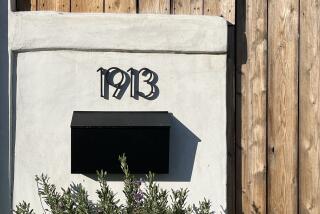A Good Place to Start Out, and to Stay Put : Norwalk: Affordable housing lures buyers; many stay for the schools, shopping and location.
- Share via
When Don and Margaret Arnett went house hunting in Norwalk they had three requirements. They needed a corner lot because they wanted RV parking, they wanted the affordability of the housing available in the city and they wanted to be freeway close.
They can see the San Gabriel (605) Freeway from their home, and when the I-1O5 (Glenn Anderson Freeway, also referred to as the Century Freeway) opens (scheduled for fall, 1993), they will be close to two freeways.
“Our house overlooks the new Century Freeway,” said Don Arnett. “I can’t wait until it’s done. It will be really pretty. I can see the archway now. It’s different than having houses across the street to look at.”
Living within sight and sound of two major freeways is not a problem to Don, who is a truck driver. “The freeway does not bother me. This is my second house by a freeway and I got used to it. I wouldn’t have bought again if it had been a problem. The convenience of being by the freeway is another plus. It’s easy access to go north or south.”
The Arnetts purchased the three-bedroom, one-bath home for $165,000 in February, 1990, in a tract of older homes with lots of trees.
“It’s an average tract home,” he said. “Middle-class people. I had some of the trees taken out as they were uprooting the sidewalk. The city came out and took them out and planted new ones. I inspired a lot of the neighbors to do the same.”
Norwalk was incorporated in 1957 with a population of 83,010 following a decade of rapid growth from 8,400 in 1947. Four years before incorporation, in 1953, the Santa Ana (5) Freeway, which runs through a major portion of Norwalk, was dedicated.
Along with the developments and influx of residents to what had been primarily an agricultural community came traffic congestion. Today, Norwalk, with a population of 94,792, is primarily viewed as a bedroom community, with pockets of industrial and some commercial areas.
Surrounding Norwalk are the cities of Santa Fe Springs to the north and east, Cerritos and Artesia to the south, and, to the west, Downey and Bellflower.
The San Gabriel River forms Norwalk’s western border. The river earlier was known as San Jose Creek, and back in 1857 the land on both sides was considered for a vineyard, (according to “A History of Norwalk” by Richard L. Kahanek). The vineyard proposal never materialized, however.
Flooding throughout the years has played a role in the area’s history. In 1867-68 the waters of San Jose Creek rose in an epic flood that inundated thousands of acres of surrounding land and resulted in the formation of the San Gabriel River we know today. Now the river, like most of those in the Los Angeles Basin, is a wide concrete-lined channel where winter and spring runoff is controlled by upstream dams.
During the 1860s, the 46,806-acre Abel Stearns Rancho was surveyed and mapped for sale and a promotion was begun that brought families from Texas, Oregon, and other developments in California.
In December of 1869 Atwood Sproul purchased a portion of land on which his brother, Gilbert, had a town site surveyed in 1874, calling it Norwalk--which was derived from North-Walk--the name of a frequently used trail. Norwalk grew and the surrounding neighborhood was planted in alfalfa, corn, beans, grapes and sugar beets. A fledgling dairy industry grew as well and the pattern continued well into the 1930s, ‘40s and ‘50s.
John Giovannoni moved to Norwalk in 1947 with his wife, Anita, and earned his living at the dairies as a milker. He is now deceased, but Anita continues to live in the three-bedroom home they bought for $9,220, where they raised five children. “When we moved here it was all fields of cabbage and other vegetables,” she said. “Rosecrans was a dirt road.”
Although realtors have encouraged Anita to sell her home, she has no plans to move. “I like it here. It’s my home.” She has seen new neighbors move in but some of the original residents are still there. Several Latino families have moved in and “have improved their homes and the neighborhood,” she said.
“I also appreciate that the City Council recently spent money on beautification of the city. Planting flowers and trees and putting Spanish architecture on some of the buildings. That was a plus.”
Anita said she has seen some problems with graffiti, but believes the council is doing a good job handling that as well.
Gene Kooiman also worked as a milker when he moved to Norwalk in 1959. He paid $15,080 for a three-bedroom, one-bath home that he sold in 1977 for $61,000, and then bought a two-story home for $70,000. He became a real estate broker in 1974 and opened his own office, Century 21 A Pioneer Co., in 1979.
He said he most often sees first-time buyers coming to Norwalk where they can find more affordable housing than elsewhere. “But Norwalk is a nice community to live in. People like the shopping, and the school system, and being close to the freeways. There are some people who have lived in their homes since they were first built 40 years ago.”
Tom Poff, of Norwalk Realty Inc., said he and his family lived in Norwalk until the 605 Freeway came through and took his house. He moved to La Mirada, but continues to operate in Norwalk.
“People come to Norwalk to buy, get some equity, stay normally five years, and move on,” Poff said. “Norwalk is primarily tract homes built in the ‘40s and ‘50s. The average price today going back over actual closings in the last several months shows the two-bedroom, one-bath at $145,931, and three-bedroom, one-bath at $166,385. Four-bedroom homes average $221,750.”
He said there are some condominium projects that are fairly new compared to the rest of Norwalk. They sell from $135,000 to $170,000.
“There are 19,928 single-family residences in the city, and 17,120 are owner occupied,” Poff said. “There are 1,219 condominium units and 5,374 apartment units. Currently in the city there are 238 listings for sale.”
Poff said Norwalk is not only centrally located with some very nice tracts, but it is a pleasant bedroom community. “There is a sense of community. People are involved in the community and in the city government.”
The No. 1 question he hears from prospective buyers concerns the school system--and the Norwalk-La Mirada Unified School District is one of the largest public school districts in California, offering a broad menu of educational opportunities including two public two-year colleges. Michell Porterfield will be one of those college students attending Cerritos College this fall. Her parents, Dan and Alice Porterfield, bought their first home--a VA no-down purchase--for $169,000. Dan, who is a Vietnam veteran, operates his own business in Norwalk, repairing furniture for Montgomery Ward on a contract basis.
The Porterfields were not strangers to Norwalk--Dan grew up there. “We wanted to live in Norwalk because it’s convenient for our business, and a lot of our friends live here,” said Alice Porterfield. “We didn’t want to move away from them. Also Dan’s mother lives here and has for 35 years.”
The best thing about their three-bedroom, one-bath house, according to Alice, other than that it’s on a nice quiet street, is “the fact that it’s mine. It’s not rented.”
Another longtime resident, Nena Lindsey, likes to tell the story of buying their Norwalk home with a $20 down payment back in 1953. As she looked at the new three-bedroom, one-bath tract home, the salesman told her they were going pretty fast. She asked if $20 would hold the house, and it did. They paid $13,000 for it. Later they added another room for a total of 1,400 square feet. She and her husband, Bill, a realtor with Home Town Realty in Norwalk, raised three children in the home.
At one time they considered moving to Orange, and actually bought a home there. But they decided they preferred Norwalk where they had established friends and good neighbors, and rented out the Orange house.
Nena Lindsey said the street on which they live has not changed much--although there was a cow pasture nearby in 1953--and that is gone.
“I was active in getting Cerritos College started. The first classes were held in milking sheds and in private houses where the milkers used to live.”
She enjoys watching the youngsters who pass by her house on the way to school. “I talk to all of them. I see different nationalities, and notice that the girls are looking more dressed up like they used to be. To my knowledge they are all compatible.”
Norwalk does not have its own police department but contracts with the Los Angeles County Sheriff’s Department for its law enforcement.
“I would say gang activity would be our most serious problem,” said Public Safety Administrator Kevin Gano. “We are focusing on this. We have developed a lot of different programs. One is our task force which consists of representatives from the City of Norwalk, the Los Angeles County Sheriff’s Department, and the school system.
“We have two 40-foot trailers that are police substations. We target specific areas where we are having problems, identify what they are, and move the unit into the area and stay until we have had an impact.”
Among other positive efforts, he said, they strictly enforce Norwalk’s 10 p.m. curfew law. Anyone under the age of 18 out on the street unsupervised by a parent or legal guardian and not going to or from a specific location is subject to arrest.
Upon a second or subsequent arrest, the parent is responsible for the costs involved, which can add up to $200, Gano said. “The law enforcement center is referred to as ‘the silver bullet’ and people are taking more control of their kids.”
Gano said they had been experiencing graffiti/gang activity and a lot of vandalism. “How we really put a dent in it was to emphasize the curfew law.”
Nena Lindsey corroborated that. There is no graffiti on her street, she said.
At a Glance Population
1991 estimate: 94,792
1980-91 change: +11.1%
Median age: 29.7 years
Annual income
Per capita: 11,298
Median household: 25,101
Household distribution
Less than $20,000: 24.6%
$20,000 - $35,000: 25.4%
$35,000 - $50,000: 23.0%
$50,000 - $75,000: 20.5%
$75,000 + 6.5%
More to Read
Sign up for Essential California
The most important California stories and recommendations in your inbox every morning.
You may occasionally receive promotional content from the Los Angeles Times.






